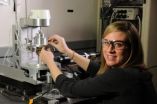(Press-News.org) A new study by a team including scientists from the National Institute of Standards and Technology (NIST) indicates that thin polymer films can have different properties depending on the method by which they are made. The results* suggest that deeper work is necessary to explore the best way of creating these films, which are used in applications ranging from high-tech mirrors to computer memory devices.
Thin films spread atop a surface have many applications in industry. Inexpensive organic solar cells might be made of such films, to name one potential use. Typically they're made by dissolving the polymer, and then spreading a small amount of the liquid out on a surface, called a substrate. The solution becomes a film as the solvent dries and the remainder solidifies. But as this happens, stresses develop within the film that can affect its structure.
Manufacturers would like to know more about how to control these stresses to ensure the film does what they want. But scientists who study film formation often use a different method of casting films than a manufacturer would. One method used in industry is "flow coating"—similar to spreading frosting across a cake. Another method is "spin casting"—placing a drop of liquid on a substrate that spins rapidly and spreads the droplet out evenly by centrifugal force. Both methods create smooth films generally, but the team decided to examine whether the two methods create different effects in finished films consisting of a self-assembling block copolymer.
"It's an important question because some proposed applications intend to take advantage of these effects," Douglas says.
The team's comparison led to results that surprised them. Although the rapid spinning of spin casting is very dynamic, suggesting it would convey more stress to the resulting film, it actually led to fewer residual stresses than flow coating did. As previous studies have shown that leftover solvent can lead to stresses in the film, the team's new theory is that because the solvent evaporates from the developing film more slowly in flow coating, this solvent discourages the film solids from arranging themselves into the equilibrium structure.
For one example, the practical benefits of this understanding could help manufacturers who propose making computer memory devices from thin films in which the solids arrange themselves as tiny cylinders in the film. Such devices would require the cylinders to stand on end, not lay down flat.
"We find we can get them to stand up much more easily with one casting method than another," Douglas says. "If we can get better results simply by varying the mode of film casting, we need to explore more deeply what happens when you make films by different methods."
INFORMATION:
* X. Zhang, J.F. Douglas and R.L. Jones. Influence of film casting method on block copolymer ordering in thin films. Soft Matter, Mar. 21, 2012. doi:10.1039/C2SM07308K.
Fabrication method can affect the use of block copolymer thin films
2012-05-04
ELSE PRESS RELEASES FROM THIS DATE:
Science nugget: Lightning signature could help reveal the solar system's origins
2012-05-04
Every second, lightning flashes some 50 times on Earth. Together these discharges coalesce and get stronger, creating electromagnetic waves circling around Earth, to create a beating pulse between the ground and the lower ionosphere, about 60 miles up in the atmosphere. This electromagnetic signature, known as Schumann Resonance, had only been observed from Earth's surface until, in 2011, scientists discovered they could also detect it using NASA's Vector Electric Field Instrument (VEFI) aboard the U.S. Air Force's Communications/Navigation Outage Forecast System (C/NOFS) ...
Ultrasound idea: Prototype NIST/CU bioreactor evaluates engineered tissue while creating it
2012-05-04
Researchers at the National Institute of Standards and Technology (NIST) have developed a prototype bioreactor—a device for culturing cells to create engineered tissues—that both stimulates and evaluates tissue as it grows, mimicking natural processes while eliminating the need to stop periodically to cut up samples for analysis. Tissue created this way might someday be used to replace, for example, damaged or diseased cartilage in the knee and hip.
Conventional methods for evaluating the development and properties of engineered tissue are time-consuming, destructive ...
Prompt Proofing Blog Post: Revisiting Homophones 3
2012-05-04
In this month's grammar post we are taking another look at some frequently confused homophones. All of the homophones below have been recently spotted, used erroneously, in business communications or copy!
Click here for our first homophones blog post, and here for our second.
insure / ensure
You only insure something in the legal sense - dealing with an insurance company. If you want to make sure something happens you will ensure it. Hence: You insure your car to ensure you will not lose out financially if it is stolen or damaged.
precede / proceed
If something ...
Study examines necessity of additional imaging in PET/CT oncologic reports
2012-05-04
Radiologists and nuclear medicine physicians recommended additional imaging about 30% of the time in oncologic PET/CT reports, with about half of those recommendations being unnecessary, a new study shows.
The study, conducted at Brigham and Women's Hospital in Boston, included 250 patients. The study found that there were 84 recommendations made for additional imaging. When study reviewers examined the patients' records, they concluded that 43 of those recommendations were unnecessary, said Atul Shinagare, MD, one of the authors of the study. No adverse patient outcome ...
6 month follow-up of patients with benign MRI-guided breast biopsies may not be necessary
2012-05-04
Short term follow-up of patients who have had a negative (benign) MRI-guided vacuum assisted breast biopsy may not be necessary, a new study indicates.
The study, conducted at Yale New Haven Hospital in Connecticut, included 144 patients with 176 lesions that were followed anywhere from three months to 36 months. The study found no malignancies on follow-up MR imaging, said Jaime Geisel, MD, one of the authors of the study. Two patients had suspicious findings at follow-up and underwent a second biopsy six months after the initial biopsy; one yielded benign results and ...
Preop MRI valuable in detecting additional malignancies in dense & not dense breasts
2012-05-04
Newly diagnosed breast cancer patients should undergo a preoperative MRI exam even if their breasts are not dense, a new study indicates. The study found no difference between the usefulness of 3T breast MRI in detecting additional malignancies and high risk lesions in dense versus non-dense breasts.
"There are currently no guidelines that define the role of breast density in determining if a preoperative MRI should be performed. However, anecdotally, we know that preoperative MRI exams tend to be ordered more frequently in younger patients and/or patients with dense ...
Spain's Balearic Islands Now Open to Charter Yachts
2012-05-04
The Balearic islands of Mallorca, Ibiza, Minorca and Formentera, along with mainland cities such as Barcelona, Valencia and Marbella can now be added to Europe's established 'charter' destinations.
With the longest summer season in Europe, and reliable sunshine from April through until late Autumn, these exclusive destinations can now add as much as 75 days to the European cruising season - This now brings a season that incorporates Easter through until the famous "Club closing parties of Ibiza" and the late Autumn sunshine on the southern Iberian peninsula. ...
Radiologists study necessity of additional imaging recommendations in PET/CT oncologic reports
2012-05-04
Advanced imaging has been identified as one factor that contributes to the overall rising cost of healthcare in the US. Unnecessary or inappropriate imaging utilization magnifies the cost burden associated with advanced imaging studies like MRIs and PET/CT scans. Though these studies often provide the best clinical information for making a diagnosis or planning treatment, experts suspect that a significant number of unnecessary studies are performed. Determining the rate of unnecessary imaging can help guide both policy-makers and physicians to develop guidelines that would ...
Comorbidities increase risk of mortality in COPD patients
2012-05-04
Comorbidities are common among patients with chronic obstructive pulmonary disease (COPD), and a number of these comorbidities are independently associated with an increased mortality risk, according to a new study.
"We followed 1,664 COPD patients recruited from five pulmonary clinics in the United States and Spain for a median of 51 months," said lead author Miguel Divo, MD, a physician in the Pulmonary and Critical Division at Brigham and Women's Hospital and Instructor in Medicine at Harvard Medical School. "Among the 79 comorbidites we observed in these patients, ...
Beehive extract shows potential as prostate cancer treatment
2012-05-04
An over-the-counter natural remedy derived from honeybee hives arrests the growth of prostate cancer cells and tumors in mice, according to a new paper from researchers at the University of Chicago Medicine.
Caffeic acid phenethyl ester, or CAPE, is a compound isolated from honeybee hive propolis, the resin used by bees to patch up holes in hives. Propolis has been used for centuries as a natural remedy for conditions ranging from sore throats and allergies to burns and cancer. But the compound has not gained acceptance in the clinic due to scientific questions about ...




